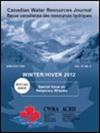Current practices in private water well management in Rural Central Alberta
IF 0.9
4区 环境科学与生态学
Q3 WATER RESOURCES
引用次数: 1
Abstract
Abstract Approximately 238,000 to 450,000 Albertans rely on private water wells for their water needs. In Canada, private well owners are responsible for monitoring and maintaining the quality of their water well, yet studies in Alberta indicate that owners do not undertake regular well maintenance or testing. This survey obtained information regarding farming and water well management practices, and drinking water preferences among private well owners in central Alberta. Questionnaires, water samples and drilling report information collected from 97 respondents between March 2015 and June 2017 were evaluated. Total coliforms were present (TC+) in 20/97 samples. There were no significant associations between well design and construction characteristics and the presence of TC+. Twenty-four and 20 respondents reported undertaking annual bacterial and chemical testing, respectively. Twenty-five respondents indicated their well had been shock chlorinated within the past three years. Concern about contamination (n = 28) was not significantly associated with increased frequency of water quality testing, well maintenance with shock chlorination, or purchasing of bottled water as an alternative drinking water. There has been little change since 2010 in the uptake of free water testing provided by Alberta Health Services. The organoleptic properties of water reported by respondents indicated shock chlorination might benefit a number of premises. Poultry producers are more likely to test their well water for bacterial and chemical contamination on an annual basis due to mandatory requirements stipulated by the poultry industry. There may be potential for a similar mandatory water testing guideline to be implemented for beef producers in Alberta. There is a need for education programs targeting rural well owners. The Working Well program information packages provided by the Government of Alberta provide an excellent source of information for water well owners. This survey indicates that new ways to disseminate this information to a broader audience are required.阿尔伯塔省中部农村私人水井管理的现行做法
大约238,000至450,000艾伯塔省人依靠私人水井满足他们的用水需求。在加拿大,私人井主负责监测和维护其水井的质量,但阿尔伯塔省的研究表明,业主不进行定期的水井维护或测试。这项调查获得了有关农业和水井管理实践的信息,以及阿尔伯塔中部私人水井所有者对饮用水的偏好。对2015年3月至2017年6月期间收集的97名受访者的问卷、水样和钻井报告信息进行了评估。97份样品中有20份存在总大肠菌(TC+)。井的设计和施工特征与TC+的存在之间没有显著的关联。24个和20个受访者分别报告每年进行细菌和化学测试。25名受访者表示,他们的井在过去三年内被电击氯化。对污染的担忧(n = 28)与水质检测频率的增加、用冲击氯化法维护水井或购买瓶装水作为替代饮用水没有显著关联。自2010年以来,艾伯塔省卫生服务局提供的免费水检测的采用情况几乎没有变化。答复者所报告的水的感官特性表明,冲击氯化可能使许多处所受益。由于家禽业规定的强制性要求,家禽生产者更有可能每年对井水进行细菌和化学污染检测。阿尔伯塔省的牛肉生产商可能会实施类似的强制性水检测指南。有必要针对农村井主开展教育项目。艾伯塔省政府提供的工作井方案信息包为水井所有者提供了极好的信息来源。这项调查表明,需要有新的方法向更广泛的受众传播这一信息。
本文章由计算机程序翻译,如有差异,请以英文原文为准。
求助全文
约1分钟内获得全文
求助全文
来源期刊

Canadian Water Resources Journal
WATER RESOURCES-
CiteScore
2.90
自引率
5.90%
发文量
17
审稿时长
>12 weeks
期刊介绍:
The Canadian Water Resources Journal accepts manuscripts in English or French and publishes abstracts in both official languages. Preference is given to manuscripts focusing on science and policy aspects of Canadian water management. Specifically, manuscripts should stimulate public awareness and understanding of Canada''s water resources, encourage recognition of the high priority of water as a resource, and provide new or increased knowledge on some aspect of Canada''s water.
The Canadian Water Resources Journal was first published in the fall of 1976 and it has grown in stature to be recognized as a quality and important publication in the water resources field.
 求助内容:
求助内容: 应助结果提醒方式:
应助结果提醒方式:


